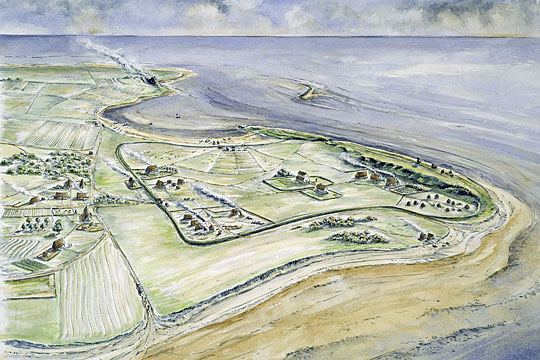Research on Lindisfarne Priory
Research on Lindisfarne has focused on the history of the Anglo-Saxon monastery, as told through contemporary accounts (especially those concerning Cuthbert), and on the early sculpture and manuscripts that have survived. The later medieval buildings of the priory and their connection with the mother-church at Durham have also been studied.

Research to date
As Lindisfarne is one of the earliest monasteries and bishoprics in England, the sources for its history have been scoured for what they reveal about the processes of conversion and the consolidation of Christianity in England in the 7th and 8th centuries.
Similarly the sources for the cult of St Cuthbert, which began at Lindisfarne, have been extensively studied. Cuthbert’s is one of the best-documented medieval saints’ cults from the British Isles. Cuthbert’s original wooden tomb, and the objects that were placed in it, provide parallels to contemporary manuscripts, metalwork, and textile design, as well as evidence of Anglo-Saxon attitudes to death and belief.[1]
Traditionally the Lindisfarne Gospels were thought to have been made for the translation of the relics of St Cuthbert in 698.[2] A new theory argues that they were made in the first quarter of the 8th century, during the bishopric of Eadfrith (d. 721), who is named as the maker of the book in a 10th-century colophon appended to the manuscript.[3] This new date is important because so many other Anglo-Saxon artefacts are dated by reference to the designs of the Lindisfarne Gospels.
Archaeological excavations in the 1980s discovered a 9th-century farmstead at Greenshiel, on the north side of the island. The bones of hundreds of young cattle were found there, leading to the suggestion that it might have been a site for preparing parchment for use in the monastery’s scriptorium.[4]
The Anglo-Saxon sculpture from Lindisfarne has been systematically recorded, catalogued and photographed as part of a project to record all the pre-Conquest sculpture from England.[5]
The Northumbrian royal fortress at nearby Bamburgh was excavated in the 1950s and is now the focus of a large-scale community archaeology project.
Lindisfarne Priory has been studied as a cell of the powerful monastery at Durham, through the evidence of the standing buildings[6] and the historical sources.[7]
Questions for future research
- Does any archaeological evidence survive for the Anglo-Saxon monastery, underneath or around the site of the late medieval priory buildings and the modern village?
- How many other surviving manuscripts can be attributed to the Lindisfarne scriptorium, and what identifies them as Lindisfarne productions?
- How did the monks obtain the raw materials needed to make these manuscripts (the animal skins for the parchment, the pigments and inks, and the exemplars for the texts and illustrations)?
- Where did the scribes and bookmakers learn their craft?
- What does a study of the landscape, archaeology and historical sources reveal of the relationship between the ecclesiastical and secular sites at Lindisfarne and Bamburgh?
- What does the Anglo-Saxon sculpture (date, function, designs) reveal about the monastery and its longevity?
- Some of the Anglo-Saxon grave markers carry women’s names. What does this tell us about the role of women in the religious life of the monastery?
- How does the sculpture from Lindisfarne compare with other contemporary Northumbrian sculpture? What does this reveal about Lindisfarne’s wider contacts?
- The illustrated ‘Life of St Cuthbert’ from Durham[8] is contemporary with the refoundation of Lindisfarne Priory; was there a direct connection?
- How do the later medieval documentary sources from Lindisfarne reflect the reality of border life during the 14th-century Anglo-Scottish wars? All the sources have been printed and translated,[9] but have not been systematically studied and are ripe for investigation.
- When did the village develop, and what was its relationship with the priory (before and after the Suppression)?
- What do the structures on the Heugh reveal about Tudor maritime defences?
READ MORE ABOUT LINDISFARNE PRIORY
Footnotes
1. CF Battiscombe (ed), The Relics of Saint Cuthbert (Oxford, 1956); G Bonner, C Stancliffe and D Rollason (eds), St Cuthbert: His Cult and His Community to AD 1200 (Woodbridge, 1989).
2. TD Kendrick (ed), Evangeliorum quattuor Codex Lindisfarnensis, 2 vols (Olten and Lausanne, 1956).
3. MP Brown, The Lindisfarne Gospels: Society, Spirituality and the Scribe (London, 2003).
4. D O’Sullivan and R Young, English Heritage Book of Lindisfarne Holy Island (London, 1995), and D O’Sullivan, ‘Space, silence and shortage on Lindisfarne: the archaeology of asceticism’, in Image and Power in the Archaeology of Early Medieval Britain: Essays in Honour of Rosemary Cramp, ed H Hamerow and A McGregor (Oxford, 2001), pp 33–52.
5. See R Cramp (ed), Corpus of Anglo-Saxon Stone Sculpture, vol 1: County Durham and Northumberland (Oxford, 1977); see also the Corpus of Anglo-Saxon Stone Sculpture website (accessed 22 March 2013).
6. E Cambridge, ‘The masons and building works of Durham Priory, 1339–1539’, unpublished PhD thesis (Durham University, 1992; accessed 22 March 2013).
7. T Johnson South (ed), Historia de Sancto Cuthberto (Cambridge, 2002); WM Aird, St Cuthbert and the Normans: The Church of Durham, 1070–1173 (Woodbridge, 1998).
8. Now Oxford, University College MS 165.
9. J Raine, The History and Antiquities of North Durham … (London, 1852).